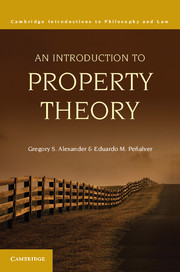Book contents
Introduction
Published online by Cambridge University Press: 05 June 2012
Summary
Disputes over rights of private ownership of property constitute some of the most contentious political issues of our day. Can the government legitimately take property from those with more solely in order to give it to those with less? Can it take someone’s land in order to help a private developer build a large shopping center that will bring badly needed jobs and tax revenue to a decaying downtown? To what extent can a business owner control who can come onto her property? Should neighbors have a say in how an owner uses property? Should an owner be allowed, without anyone’s input, to tear down an important historic building in order to build a more profitable modern office tower? Should she have the right to fill sensitive wetlands in order to build a home?
Property disputes raise passions, at both personal and political levels, like few other topics can. It is not surprising, then, that some of the most important thinkers in history have focused sustained attention on the nature of and justifications for ownership. In this book, we will provide an introduction to the answers these theorists have proposed.
- Type
- Chapter
- Information
- An Introduction to Property Theory , pp. 1 - 8Publisher: Cambridge University PressPrint publication year: 2012



